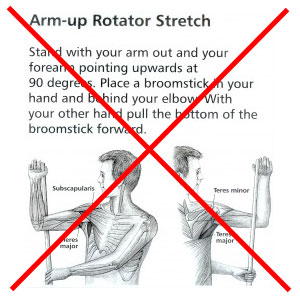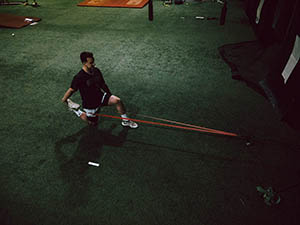 When most pitchers first learn high velocity pitching mechanics, like with the revolutionary approach called 3X Pitching, they quickly discover the importance of range of motion. Harder throwers can create more range of motion between the hips and shoulder and also in the throwing shoulder during external rotation or the late cocking phase.
When most pitchers first learn high velocity pitching mechanics, like with the revolutionary approach called 3X Pitching, they quickly discover the importance of range of motion. Harder throwers can create more range of motion between the hips and shoulder and also in the throwing shoulder during external rotation or the late cocking phase.The problem is these pitchers will jump to conclusions that the answer to increasing pitching velocity is to only increase range of motion. Well if you have a basic understand of the laws of physics you will know that if you increase range of motion but reduce force in return then you are working against yourself.
For an increase in a pitcher's range of motion to enhance pitching velocity, the forces coming from this movement must remain the same or hopefully they will also increase with the added range of motion. The key to increasing pitching velocity through more range of motion is with speed and not just with flexibility. Most pitchers will try to take this approach to using flexibility training to increase range of motion. They will stretch and stretch and stretch the arm, through a full range of motion, in hopes this will increase pitching velocity. In many cases this flawed approach reduces pitching velocity.
Before we look into the issues of stretching to enhance performance, let's first learn the science that proves the correlation between high velocity pitching and increased range of motion, specifically in the shoulder. The shoulder is the most common place for pitchers to use stretching techniques to increase range of motion because the shoulder is easier to stretch than the core.
Scientific Proof High Velocity Pitchers have More Range of Motion
 A study performed by the likes of Dr. James R. Andrews and Dr. Glenn S. Fleisig of ASMI called, Comparison of Kinematic and Temporal Parameters Between Different Pitch Velocity Groups, proved that "the hard throwing group was able to get their arms back into 179 degrees of rotation whereas the slow group could only get 166.3 degrees." This picture here of Billy Wagner has him at 179 or greater. Studies like this are slowly moving into the conventional wisdom of the game and the interpretation is being lost in translation. When pitching coaches and young pitchers should always be looking at pitching mechanics through the entire kinetic chain, the masses are ignoring the chain and trying to force a mechanical adjustment unnaturally. This unnatural adjustment would be to overstretch the shoulder joint of a low velocity pitcher to create the same range of motion of the high velocity pitcher.
A study performed by the likes of Dr. James R. Andrews and Dr. Glenn S. Fleisig of ASMI called, Comparison of Kinematic and Temporal Parameters Between Different Pitch Velocity Groups, proved that "the hard throwing group was able to get their arms back into 179 degrees of rotation whereas the slow group could only get 166.3 degrees." This picture here of Billy Wagner has him at 179 or greater. Studies like this are slowly moving into the conventional wisdom of the game and the interpretation is being lost in translation. When pitching coaches and young pitchers should always be looking at pitching mechanics through the entire kinetic chain, the masses are ignoring the chain and trying to force a mechanical adjustment unnaturally. This unnatural adjustment would be to overstretch the shoulder joint of a low velocity pitcher to create the same range of motion of the high velocity pitcher.
The correct interpretation of this data is that these high velocity pitchers have more range of motion in the throwing shoulder than the low velocity group because they have generated more linear power from the stride and converted it through the hips to torso which has multiplied the speed of shoulder rotation and pushed them into forward trunk tilt. These higher shoulder speeds along with the linear trunk movements of the high velocity group is what is pulling the arm back into this full range of motion like in the picture here. Yes, these high velocity pitchers have more flexibility but this flexibility has been conditioned through the repetition of their faster throwing kinematics. These pitchers did not overstretch the joint to get to this full range of motion, it comes naturally as a product of their training and speed mechanics.
Scientific Proof Stretching Reduces Pitching Velocity
Here is proof that these high velocity pitchers are not overstretching the shoulder joint to create their full range of motion. A study hosted at San Diego State University called, Effects of stretching the upper limb on throwing speed and isokinetic shoulder torques, holds the evidence. Here are the results from the study:
Significant interactions were found for throwing speed and isokinetic torque at 3.14 rad/s (but not for isokinetic torque at 5.24 rad/s). Stretching reduced throwing velocity and shoulder isokinetic torque at the slower isokinetic speed.
Read the entire study here: http://coachsci.sdsu.edu/csa/vol111/noffal.htm
This study specifically states that low velocity pitchers who throw with slower isokinetic speeds, stretching reduced throwing velocity. Another study performed at the Department of Physical Therapy, College of Health Professions, Wichita State University, called, Static and Dynamic Warm-up in Upper Extremity Functional Activities, states a similar result from the previous study. Here are the results from this study:
Dynamic Warm-Up might offer performance benefits not found with Static Warm-Up prior to performance of selected strength testing and functional closed kinetic chain activity in the Upper Extremity.
Read the entire study here: http://soar.wichita.edu/dspace/bitstream/handle/10057/2280/GRASP5_54.pdf
This study also proves the negative effects of static stretching on the upper extremity but then points to the more beneficial approach of the dynamic warm-up. The dynamic warm-up is a critical part of the Fusion System in the 3X Pitching Velocity Program.
Steps to Enhance Range of Motion Without Reducing Performance
There is a series of mechanical steps a pitcher can make to increase range of motion in the throwing arm without reducing pitching velocity. These mechanical steps require a good understanding of a high velocity pitching delivery or the 3X Pitching Mechanics. Here is a list of these mechanical steps along with a description:
- Enhance Force Production - Increasing the amount of linear power a pitcher can generate through the stride phase. This will speed up the delivery which if converted at front foot strike into hip to shoulder separation, will multiply the speeds of the shoulder rotation leading to optimal external rotation of the throwing arm.
- More Hip to Shoulder Separation - Building more core torque increases shoulder rotation speeds along with more shoulder abduction. Both these components combined will enhance external rotation of the throwing arm.
- The Tilt - Tilting the body back over the butt during the stride into front foot strike will also support hip to shoulder separation and shoulder abduction.
- Front Leg Stabilization - If the linear power of the stride is stopped at front foot strike with a stable front leg then the trunk will push forward as the shoulders rotate and the arm will absorb more of the power from the stride enhancing external rotation. Lead knee flexion is detrimental to external rotation of the throwing arm.
There is also a series of training steps a pitcher can use to increase range of motion in the throwing arm without reducing pitching velocity. These steps are to be performed in a strength and conditioning program like the Fusion System in the 3X Pitching Velocity program.
- Dynamic Warm-up - This is a routine of moving and stretching the body naturally. This routine will prevent performance loss because the body is pushed into a full range of motion based on the speed of the movement which is similar to performance.
- Shoulder Tubing - Using resistance tubing to train mobility more than flexibility in the throwing arm will not effect performance because it is mainly focused on strength over range of motion. More strength in the joint should support more range of motion. The goal is to promote joint integrity which will create a better environment for full range of motion.
- Throwing Drills - Using specific throwing drills that put low amounts of stress on the arm but train the throwing arm through a full range of motion is key to enhancing flexibility without reducing performance.
As you can see using the mechanical and training steps to increase a pitchers range of motion in the throwing arm, over just static stretching, is a more natural and effective way to implement the high velocity component of optimal external rotation of the throwing arm. All of these steps are used in the 3X Extreme Pitching Velocity Program all season long which has a significant effect on enhancing range of motion in the throwing arm as a high velocity pitcher is developed.




The reason any strength is lost in stretching is because your body doesn’t know how to lengthen and contract in the new range of motion it has gained. This is a completely biological process. If I constructed a catapult with a hard, rigid wood for the arm, there would be little elastic potential energy to heave the ammunition. If I revamped the catapult with a more flexible arm, immediate results would be seen as the catapult would throw farther, and subsequently FASTER. A catapult is not sentient and therefore doesn’t care if it injures itself. This can be seen as an analogy for the H-reflex in our muscles. Static and particularly ballistic stretching can and should be utilized whether it is your external rotators or your gracilis muscles if you are a velocity-based athlete. The reason you LOSE velocity after/during/before you stretch is because your nervous system is weary and doesn’t have the kinesthetic knowledge yet to lengthen and produce loads of force in this new range of motion. This is why we are at more risk of injury, so your nervous system mediates this and tells your body to produce less force. Quite simple actually. One should not avoid any form of stretching because of these inherent side effects; that would not be looking at the whole picture. When a pitchers arm is in total terminal external rotation, the stretch reflex is what whips that ball hard, not the strength of your muscles. Leave the strength to the lower body and core. Judging stretching and lengthening as a burden to athletic movement is a very naive take on kinesthetics. It takes time to create functional strength and mobility in places we have never used it.
I feel like it is implied in this article that only internal and external rotation stretching are bad which I believe from experience. Other forms of stretching are definitely beneficial. The exercises mentioned definitely help add range of motion in places that need them.